High quality in a small size for astrophotography: SIGMA 35mm F1.4 DG DN | Art


The life and adventures of an astrophotographer can be a bit outside of the box. Although we spend most of our time working in the dark we’re still very much concerned with light. We spend hours in the middle of nowhere to collect light from stars and avoid light from cities and towns. We travel long distances and make demands from our gear that few other photographers do. It’s always an adventure, but with the proper planning and gear, it can be incredibly rewarding.
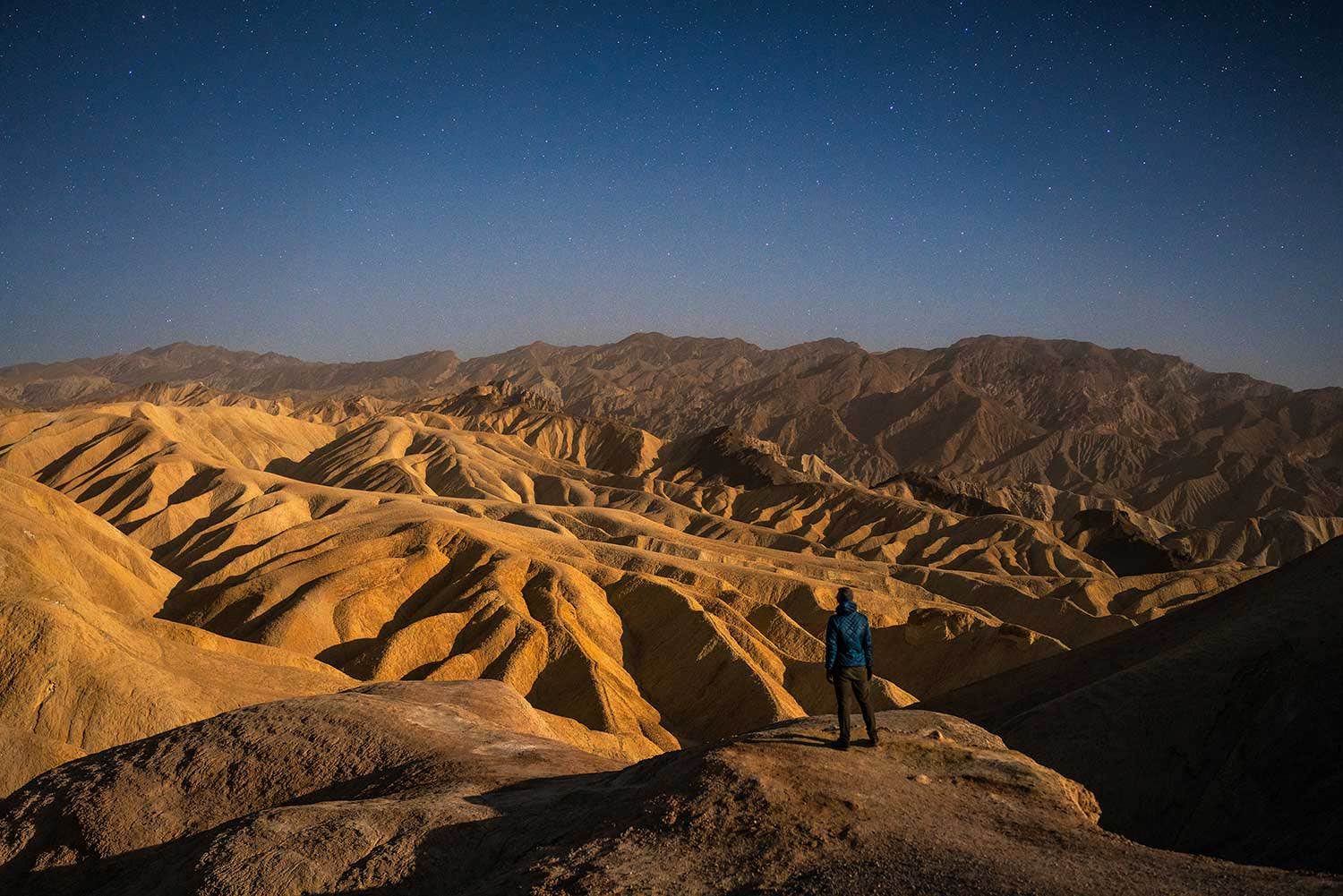

The 35mm focal length provided the perfect scale for this otherworldly landscape.
SIGMA 35mm F1.4 DG DN | Art, Sony α7R III, ISO 1600, F2, 6 s
That’s where the new SIGMA 35mm F1.4 DG DN | Art lens comes in. Now, there are a few things that I always look for when it comes to an astrophotography lens.
• Fast Aperture
• Bright and Sharp from edge to edge
• Built to Last
• Lightweight
To be honest, it’s a pretty standard wish list for a prime lens and the SIGMA 35mm F1.4 DG DN | Art checks them all. When heading out, I’m much happier with a lighter bag filled with the right gear than a bag full of options I’ll never use or need. While the DSLR versions of the SIGMA Art line have long been a staple in my bag, the lighter weight and more compact footprint of the newly designed mirrorless versions have been a very welcome addition on my journeys.
A large number of my images are planned weeks to months in advance. A combination of waiting for the right Moon phase, waiting for the weather to cooperate, and quite literally waiting on celestial objects to align make it important to be ready when the moment comes. At pretty much any given time I can rattle off a number of images that I have planned out over the course of the upcoming year.
I instantly thought of Death Valley, when picking a destination to take the SIGMA 35mm F1.4 DG DN | Art for its first night sky expedition. Not only is Death Valley one of the most famous National Parks, it was also designated as an International Dark Sky Park in 2013. My plan was to spend a night photographing it under the Moon to show off its incredible landscape underneath the stars and then return near the New Moon to show why it was designated as a Dark Sky Park.
Moonlit Single Exposures


Strong winds brought low clouds and dust filling the valley below
SIGMA 35mm F1.4 DG DN | Art, Sony α7R III, ISO 1600, F2.8, 6 s
Sitting at 5,476 feet (1,669 m), my first Moonlit stop would be Dante’s View. Low clouds and dust kicked up on the valley floor made for dramatic conditions below, but unfortunately for me meant that intense winds were ripping through the trail. The wind advisory was calling for things to die down a bit before I started shooting, but there were very few signs of it letting up.
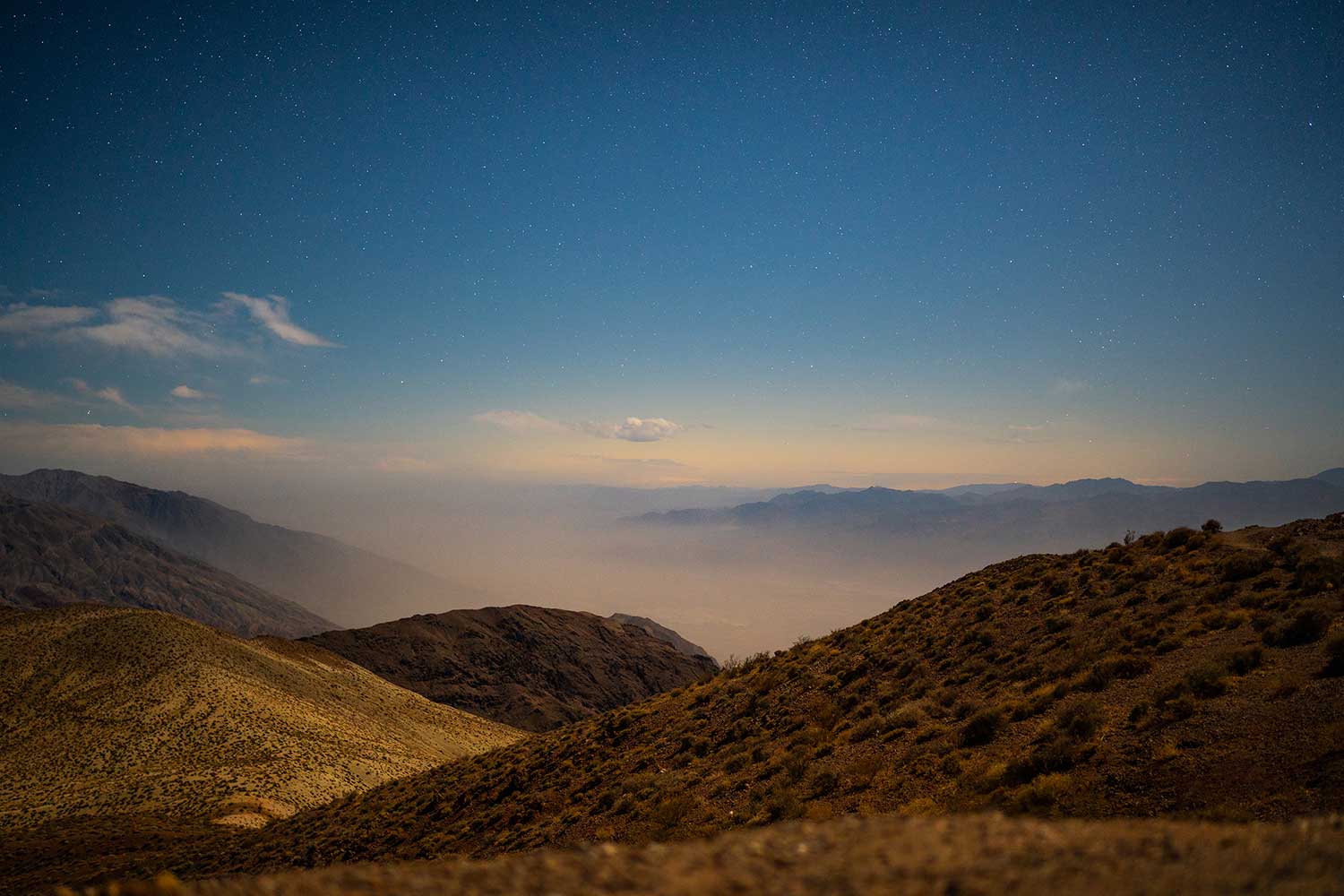

The bright Moon and fast aperture allowed me to bring out detail in layer after layer
SIGMA 35mm F1.4 DG DN | Art, Sony α7R III, ISO 800, F1.4, 6 s
A combination of the fast aperture and Moonlight allowed me to take shorter exposures. I tried to use this to my advantage during the short lulls in the wind. This was my first real interaction with the aperture ring on the lens and I was immediately a fan. It certainly was not the ideal situation to be able to really take in the results–but quite often my favorite photos came from situations that were less than ideal. Still, I took the time to review how my images looked up closely and inspect the stars in the corners, and to put it simply, I was excited! Edge to edge, even at fastest apertures, the results were stunning.
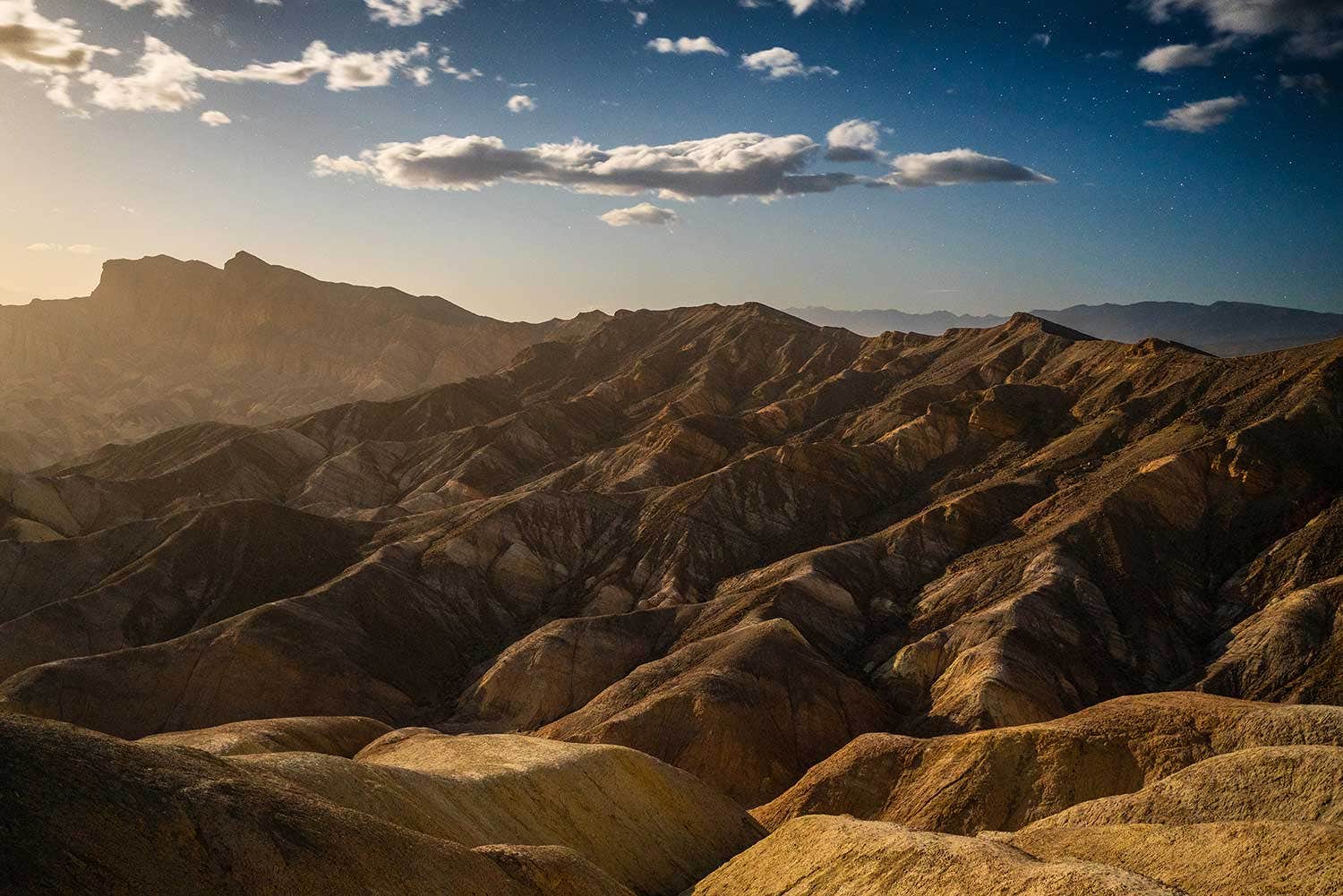

The Moonlight allowed a unique take on the scene. The sharpness of the lens was really highlighted in the details of this image.
SIGMA 35mm F1.4 DG DN | Art, Sony α7R III, ISO 1600, F2, 6 s
From here I would head to a hopefully less windy, but just as beautiful area of the park, Zabriskie Point. Often photographed at sunrise and sunset, I wanted to show off the incredible landscape features here using Moonlight.
Although astrophotography is most often photographed with ultra-wide-angle lenses (I’m right there with you, I love my SIGMA 14mm F1.8 DG HSM | Art), I really love shooting with longer focal lengths to help emphasize dramatic landscapes. This can become challenging because as your focal length increases, the amount of time you’re able to exposure for while keeping your stars looking like points of light instead of short trailing lines is shortened. With astrophotography, you either want sharp dots or artistic longer star trails, the short lines appear unintentional and don’t have the right aesthetic. This is one of the reasons I mentioned a fast aperture being an absolute necessity.
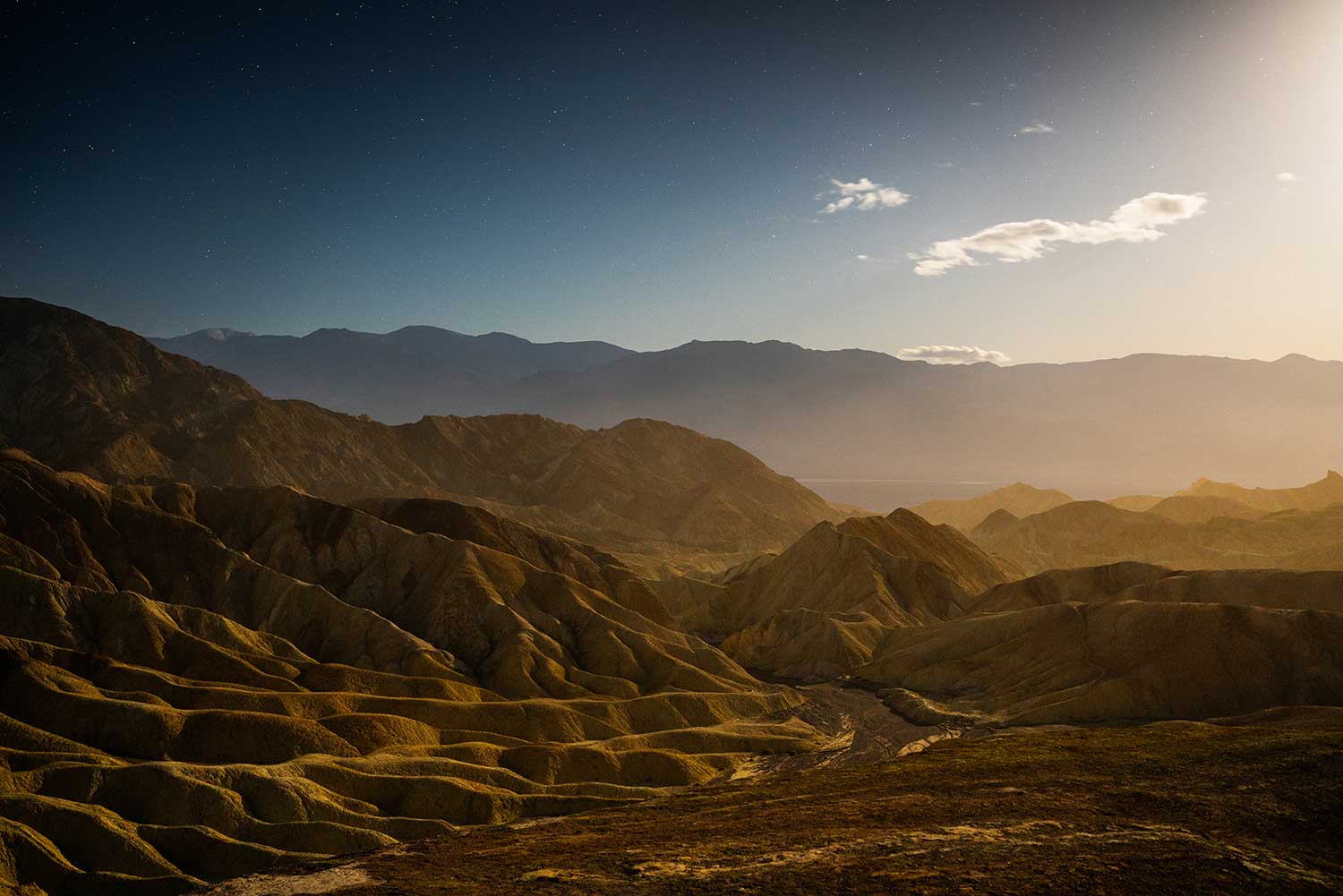

The Moon just out of frame created dramatic shadows and lighting.
SIGMA 35mm F1.4 DG DN | Art, Sony α7R III, ISO 1600, F2, 6 s


Perhaps the most famous feature of Zabriskie Point. I choose to shower it with Moonlight for a very dramatic effect.
SIGMA 35mm F1.4 DG DN | Art, Sony α7R III, ISO 1600, F2.8, 3.2 s
The winds were still kicking dust up in the distance which continued to provide that dramatic backdrop as it was illuminated by the Moon. Shot in complete darkness, the landscape here might end up looking flat with some of the features losing some of their unique qualities that draw people here in the first place.
After shooting in nearly every direction, the 35mm focal length was proving to be the perfect choice for showcasing these immense landscapes at night.
Moonlit Single Exposures


Multiple exposures allowed me to carefully bring out and highlight detail in this immense canyon.
SIGMA 35mm F1.4 DG DN | Art, Sony α7R III, ISO 3200, F1.4, 52 s
My last Moonlit location would be the Natural Bridge Trail. A short 1-mile hike would reveal a 50ft arch across an impressive canyon. I knew this location would be difficult to shoot with little Moonlight actually reaching inside the depths of the canyon.
My approach here drifted from the single exposure approach of my previous stops. I knew I would need at least a longer exposure and possibly some sort of external light to help highlight the details. Once I had a composition I was happy with, I was ready to start figuring it out.


A look at all three individual exposures and their specific purpose in creating the final image shown above.
SIGMA 35mm F1.4 DG DN | Art, Sony α7R III, ISO 3200, F1.4, 5 s
Duotone is the second new color mode available on the fp L. But it is really more than that: a collection of color modes in one. Though a bit overwhelming at first, it became very fun to play with because of the nature of the different settings. They are not all equally contrasted. In fact, some might bring interesting texture in dark setups, while others would work best with brighter subjects. Shooting a similar subject with multiple Duotone modes to begin with allowed me to get familiar with them. I certainly now have my favorites.


Creating scale and helping add a sense of wonder to the image by adding a human element.
SIGMA 35mm F1.4 DG DN | Art, Sony α7R III, ISO 3200, F1.4, 5 s
A short 5 second exposure for the sky kept the canyon completely silhouetted. My next exposure would be closer to a minute long to pick up a bit of light on the side of the arch closest to me and some detail further down the canyon. After this, I set a timer so I could use my headlamp to provide a soft light hitting the back and under side of the canyon providing a warm glow. Although these were three separate exposures on the back of my camera, I could tell they would sit together nicely.
Although I was happy with how the lighted scene would work, I wanted to take one more image to help emphasize the massive scale of this arch. I set another timer and used my headlamp as a lantern to help light the scene while standing in it. Click, run in to place, hold still, hold still, run back and review. A few tries and I was stoked on the results.
Designated Dark Skies
After seeing the results of my night of shooting under Moonlight, I was even more excited to make my way back near the New Moon while the skies would be at their darkest. My plan was to make my way through the park using a variety of shooting techniques while putting the SIGMA 35mm F1.4 DG DN | Art to its first truly dark sky test.
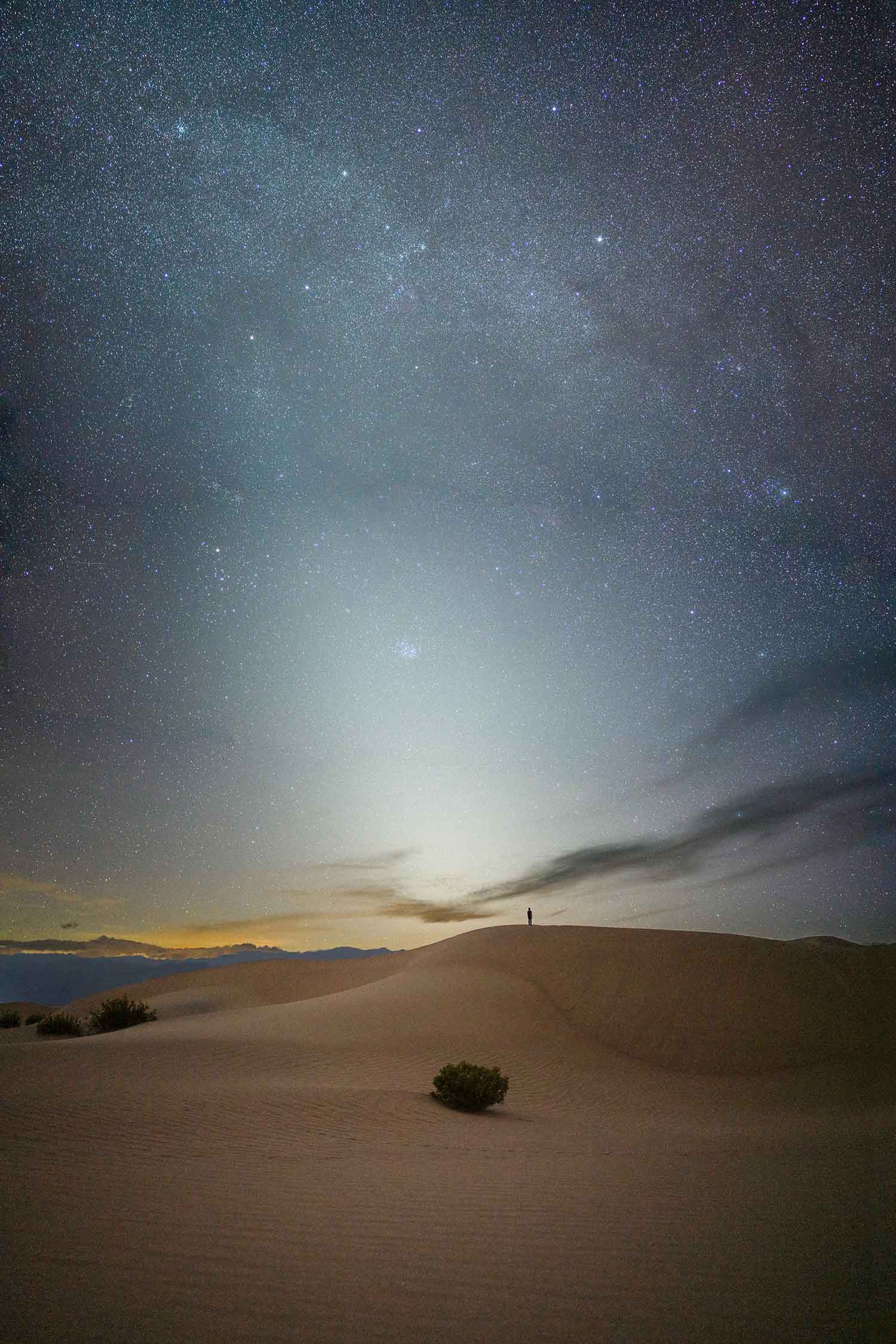

About an hour after sunset, particles of space dust are lit up by remaining sunlight creating a faint glow called the zodiacal light. I shot the first two images of the sky and then set the camera on a timer for a very tiring sprint up the distance dunes.
SIGMA 35mm F1.4 DG DN | Art, Sony α7R III, ISO 3200, F1.4, 10 s
I decided to start my evening at the Mesquite Sand Dunes with hopes of catching the zodiacal light after sunset. While known for being a very faint glow, I was blown away by how brightly visible it was due to the lack of light pollution. Although I spent some time taking photos during blue hour, I had my composition already picked out for capturing the zodiacal light. Shooting the foreground of my vertical panorama allowed me to run up the dunes in the distance adding some much-needed scale to the image.
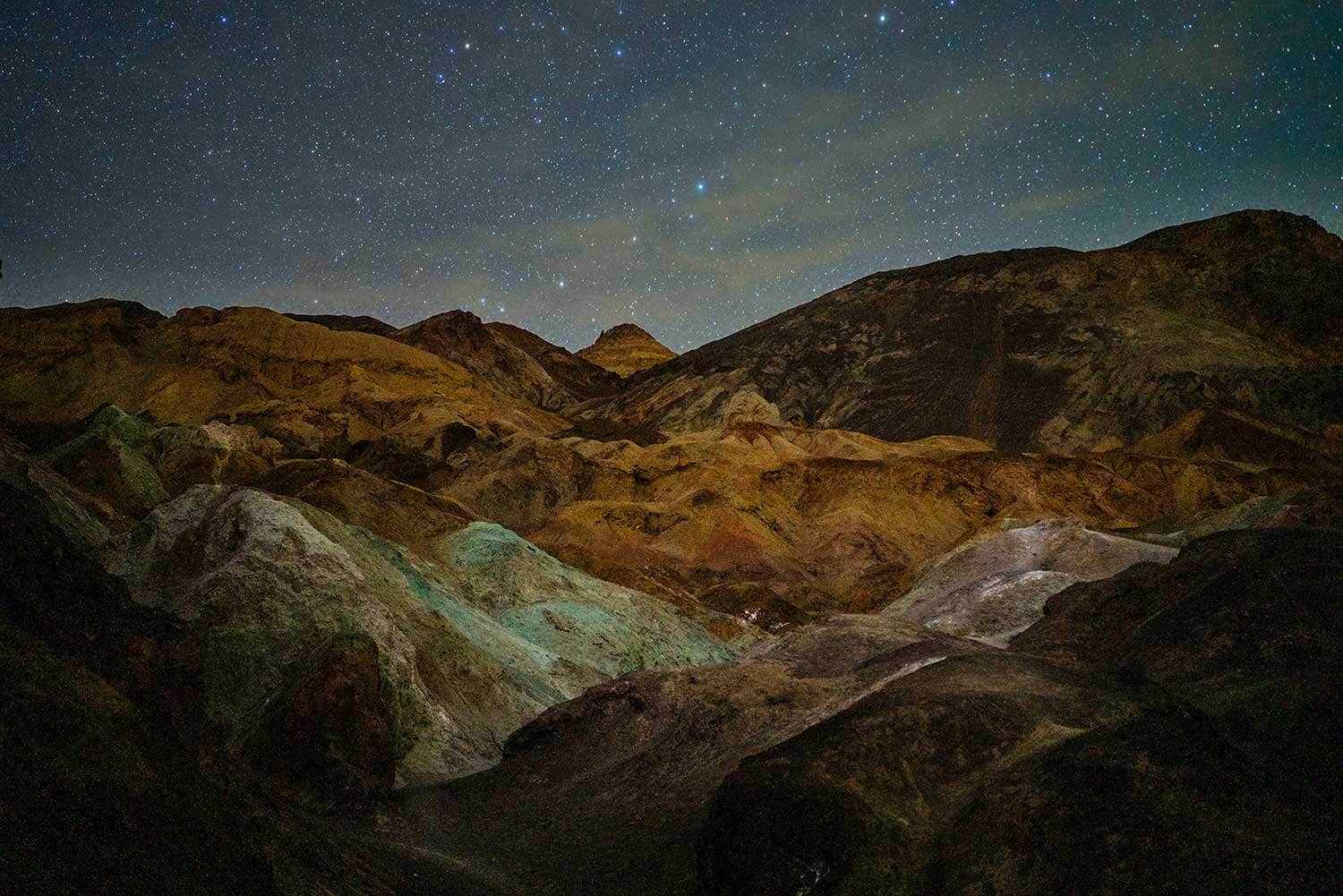

To help bring out more of the colorful detail in this unique canyon, I chose to shoot a longer exposure for the foreground.
I shot the sky at a shorter exposure to keep the stars sharp and combined the two exposures in post.
SIGMA 35mm F1.4 DG DN | Art, Sony α7R III, ISO 3200, F1.4, 10 s
After leaving the sand dunes, I drove across the park making my way to the Artists Palette. This area is known for its vibrant and unique colors caused by oxidation of metals in the rock. Without any ambient light, I shot a 60 second exposure for the foreground lit purely by the stars to pick up some of the unique colors in the rock. After the minute long exposure, I took a 10 second exposure for the sky and combined the two exposures in post processing.
A Short Window with the Milky Way
While I was excited about the images from the first part of my evening, I was even more excited for my last two locations. I planned the night so I would arrive at the famous salt flats of Badwater Basin just as the Milky Way would be rising above the horizon. This would be the perfect location to capture the stars using two different techniques. I planned on using a star tracker, a device that allows for longer exposures while keeping the stars sharp by very slowly rotating, and also taking images to stack in post processing to reduce noise.
The fast aperture paired with the live view of my mirrorless camera made focusing on a bright star incredibly easy at each location. I took my first test frame at Badwater Basin, shooting with the lens wide open at F1.4. The amount of detail and sharpness across the frame was stunning. I spent a few seconds reviewing the Milky Way on the back of the camera and began shooting a huge panoramic image using the star tracker for the sky and then turning it off for the foreground exposures.
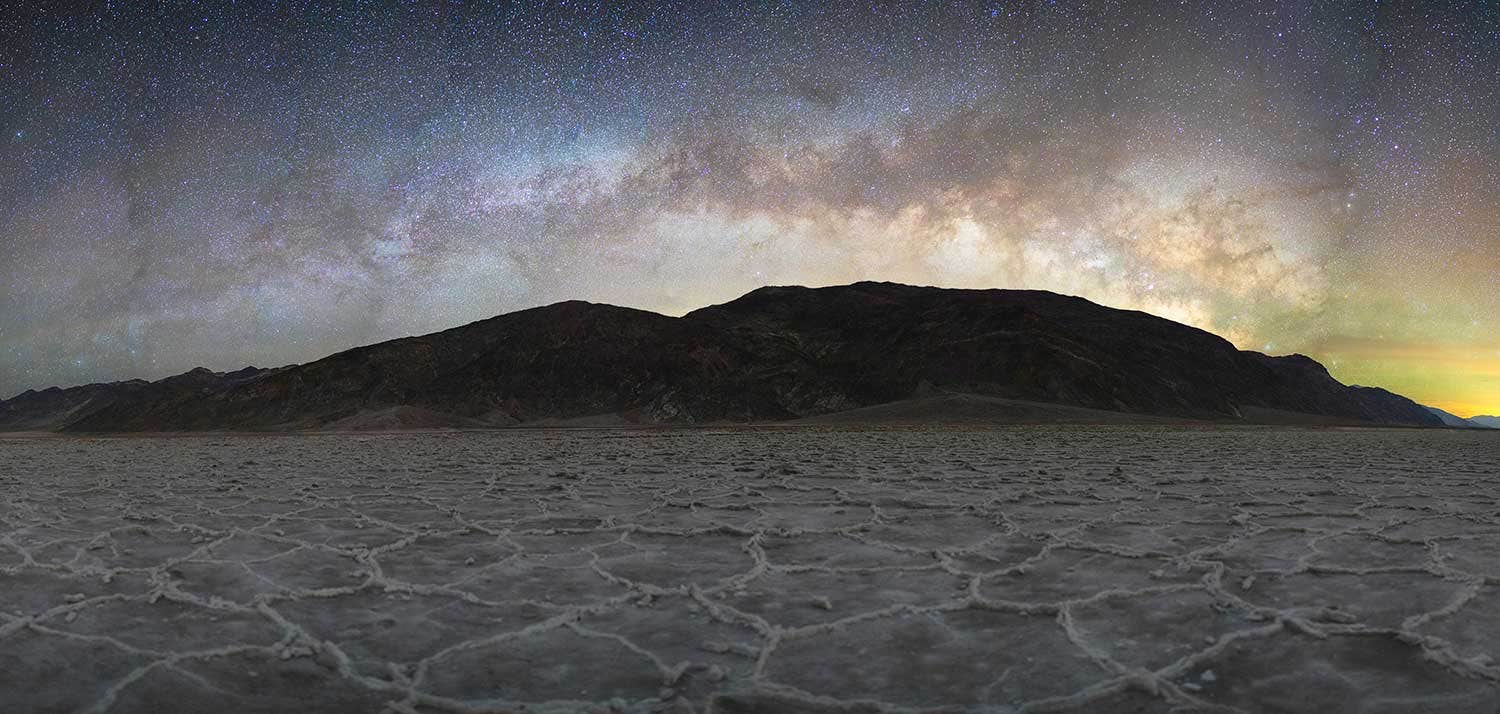

A star tracker paired with the fast aperture allowed for an incredible amount of detail in the Milky Way in this massive panorama.
SIGMA 35mm F1.4 DG DN | Art, Sony α7R III, ISO 3200, F1.4, 30 s
Once I was finished shooting the panorama, I wanted to use a technique that didn’t require any additional equipment. Taking multiple exposures at a high ISO and then stacking them during post processing helps create a detailed and clean image.


This image was created by taking consecutive exposures and stacking them during post processing to reduce noise.
SIGMA 35mm F1.4 DG DN | Art, Sony α7R III, ISO 12800, F1.4, 8 s
Once I was finished shooting the panorama, I wanted to use a technique that didn’t require any additional equipment. Taking multiple exposures at a high ISO and then stacking them during post processing helps create a detailed and clean image.
For my last stop, I planned on returning to a location I visited under Moonlight, Dante’s View. At this time of the year, the Milky Way would be just off to the left side of the trail and be in the perfect location to capture in another large panoramic image. I wouldn’t have much time, but thankfully I wouldn’t have the strong winds to deal with this time around. Racing against the quickly approaching sunrise, I shot the sky images first followed by the foreground images. I didn’t want to composite myself standing in, so I set a timer for the center foreground frame and sprinted into place.


An incredible view to end two nights of chasing the stars in Death Valley
SIGMA 35mm F1.4 DG DN | Art, Sony α7R III, ISO 3200, F1.4, 10 s
Coffee Before Sleep
There are nights where you see the image on the back of your camera and think “that will work” and then there are nights where that preview excites you enough to review it before you sleep. Safe to say, I was making coffee and reviewing images long before sleep. Safe to say, I was making coffee and reviewing images long before sleep on each night.
No matter how much planning I do, there will always be conditions that are out of my control or don’t go as planned. So, taking the SIGMA 35mm F1.4 DG DN | Art out in difficult conditions and still coming home with images that I was excited to share was a pretty convincing experience. Despite checking on the edges in the field, I was just as impressed with reviewing my edits. The Moonlit images have a sharpness to them beyond what you would expect to see at night.
All of this quality in such a small size, at debatably one of the best focal lengths for astrophotography means this lens has immediately earned a spot in my bag. I have a strong feeling I won’t be the only one that feels that way.


Jack Fusco
Astrophotographer / Timelapser
Jack Fusco is an astrophotographer / timelapser based out of San Diego, California, USA. On his often-sleepless journey, he strives to share the wonder and beauty of the night. Whether chasing the Milky Way along coast lines or capturing the aurora in unforgiving remote locations you’re sure to find him coffee in hand, smiling up at the stars.
His work has been featured by National Geographic, TEDx, LA Times, NASA APOD, BBC, Forbes and many more.

